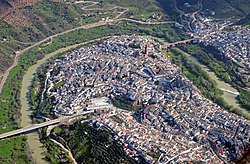
Back Guadalquivir Afrikaans ጓዳልኪቪር ወንዝ Amharic Río Guadalquivir AN الوادي الكبير Arabic جوادالكيبير ARZ Guadalquivir AST قوادالکیبیر چایی AZB Гвадалквівір Byelorussian Гуадалкивир Bulgarian গুয়াদালকিবির Bengali/Bangla
| Guadalquivir | |
|---|---|
 Montoro situated on a bend of the river. | |
 Location of the Guadalquivir | |
| Etymology | from الوادي الكبير (al-wādī l-kabīr), "the great valley" or "the great river" in Arabic |
| Location | |
| Country | Spain |
| Region | Andalusia |
| Cities | Córdoba, Seville |
| Physical characteristics | |
| Source | Cañada de las Fuentes |
| • location | Cazorla Range, Quesada, Jaén |
| Mouth | Atlantic Ocean |
• location | Almonte (Huelva) and Sanlúcar de Barrameda (Cádiz). |
• coordinates | 36°47′N 6°21′W / 36.783°N 6.350°W |
• elevation | 0 m (0 ft) |
| Length | 657 km (408 mi) |
| Basin size | 56,978 km2 (21,999 sq mi) |
| Discharge | |
| • location | Almonte (Huelva) and Sanlúcar de Barrameda (Cádiz). |
| • average | 164.3 m3/s (5,800 cu ft/s) |
| Basin features | |
| Tributaries | |
| • left | Guadiana Menor, Guadalbullón, Guadajoz, Genil, Corbones, Guadaira |
| • right | Guadalimar, Jándula, Yeguas, Guadalmellato, Guadiato, Bembézar, Viar, Rivera de Huelva, Guadiamar |
The Guadalquivir (/ˌɡwɑːdəlkɪˈvɪər/, also UK: /-kwɪˈ-/, US: /-kiːˈ-, ˌɡwɑːdəlˈkwɪvər/,[1][2][3] Spanish: [ɡwaðalkiˈβiɾ]) is the fifth-longest river in the Iberian Peninsula and the second-longest river with its entire length in Spain. The Guadalquivir is the only major navigable river in Spain. Currently it is navigable from Seville to the Gulf of Cádiz, but in Roman times it was navigable from Córdoba.
- ^ "Guadalquivir". Collins English Dictionary. HarperCollins. Retrieved 30 May 2019.
- ^ "Guadalquivir" (US) and "Guadalquivir". Lexico UK English Dictionary. Oxford University Press. Archived from the original on 2020-08-01.
- ^ "Guadalquivir". Merriam-Webster.com Dictionary. Merriam-Webster. Retrieved 30 May 2019.